
M-Speed Skyline GT-R
This is it. The ultimate tuned Skyline GT-R. Unlike the countless projects that start off promising amazing results, the boys at M-Speed actually achieved what they set out to do, and that was to build the fastest GT-R in the world. You won't see this particular R34 shoot up the dragstrip in eight seconds, this M-Speed GT-R was purely created for the Tsukuba circuit.
It's aim has always been to lap the famed Tsukuba circuit in the fastest time possible, something they achieved last year with an amazing 55.23-second lap, beating all the GT-Rs and other participants at the Rev Speed Magazine organized Tsukuba Lap Battle. However, as Matsumoto-san of M-Speed explains, this year they stepped up their game. This time they are shooting for an even quicker time. Their goal is to get 53 seconds, effectively beating the 53.589-second record posted by the HKS Lancer CT230R earlier this year, which due to some politics doesn't participate in Rev Speed events.
We met up with Matsumoto-san at a very wet Fuji Speedway. We were lucky enough to set up the shoot the day after the car was fitted with the new '07 specification body, which incidentally is also on sale to the public for those wanting to create their own M-Speed replica. As you can imagine on a car of this caliber no money is spared, which is why all the body panels are made from lightweight dry-carbon fiber. By this we mean the molded, vacuum-sealed and pressure-cooked variety of carbon, which guarantees both lightness and strength.
First off the front bumper, which features a half stock and half GT-car look, was slightly altered by removing the front indicators, an unnecessary item on a circuit-only car. By doing this, a few more 100 grams were shaved off but more importantly the aerodynamics of the front end were cleaned up. The two canards, which were previously used on each side of the bumper, were also removed. These usually help by giving more front downforce when tackling fast corners, but they also create a lot of drag and turbulence. To offset this loss, a larger and much longer carbon front diffuser was made that features its own canards on each side. This still gives excellent front downforce without disrupting the front aerodynamics. The large central opening of the bumper remains; its main job is to free the massive ARC intercooler and oil cooler as well as to direct air to each side to cool the brakes. The carbon vented bonnet is even lighter and features a large vent that flows out huge quantities of hot air, helping to keep the engine nice and cool. The front fenders are much wider than standard fenders and are beautifully designed to give an altogether new look to the front of the car.
Again, every small detail is functional like the small opening at the top of the fender, which channels hot air away from the engine, to the lower recess on the lower part to help flow more air over the side of the car, making good use of the angular skirt design. In the pursuit of lightness the doors and side mirrors are carbon. This takes us to the rear fenders, probably the most evident modification made from the '06 version of the car. The older slab-sided items were replaced with these smoothly contoured versions, which achieve the widening effect with a far cleaner and more pleasant design. These are riveted to the chassis and body, but the joint lines have been so cleanly hidden that it all looks boned-in.
The rear hasn't been altered and still runs the carbon bumper, which is exactly like a factory item and the carbon trunk lid. Downforce is everything on a track car like this, especially at Tsukuba when trying to carry as much speed as possible into the last corner, so M-Speed created a large carbon rear spoiler that sits on special adjustable stays. Completing the new look for 2007 are the graphics specially designed by Marking Office Kura. This M-Speed GT-R is instantly recognizable due to its yellow body color and green Rays Engineering Volk Racing TE37s. These are the same 11x18 items used on GT race cars and feature lightweight magnesium construction as well as a single center bolt, which means the wheel hubs were specially modified to accept them. Sticky Bridgestone RE55S semi-slick tires are used, and before you ask, slicks are against the rules at these time attack events for some strange reason.
Chassis-wise this GT-R has been prepared from the ground up just like a race car. After being fully stripped and cleaned it was spot and seam welded and reinforced in various high-stress areas like suspension mounts. A full rollcage was welded-in and additionally braced to the chassis, as can be seen around the A-pillars and on top of the windshield. Matsumoto-san explains that a lot of work went on inside the wheel arches as this car runs a full custom double wishbone layout at the front and rear. Unfortunately, we weren't able to get further details on this since a lot of engineering went into a conversion like this and they can't afford to get their ideas copied.
The Quantum dampers, running Hyperco springs, are mounted vertically instead of a more complex push-rod style layout like the GT Skyline GT-Rs used to run. Braking is down to a full Brembo Racing system made up of eight-pot front calipers and four-pot rear calipers. These share nothing with street-spec kits as the actual calipers are made from lighter alloy and have magnesium pistons. On top of this they can easily be taken apart for servicing. These are mated to huge 380mm front rotors and 324mm rear items, both using a floating type center bell mount. Hi-friction Endless pads are used and the system is pressurized by a custom master cylinder. With only 1,180 kg of mass, these brakes haul the car down from any speed in a split second!
Matsumoto-san got a lot of inspiration from the RBs that were used in JGTC. He focused on trying to develop a strong mid-range as well as a powerful top end. During our coverage of the Tsukuba Lap Battle event last year we were astonished at how fast this car shot out of the corners with instant acceleration. The engine is built around the Nismo GT block, the same "RRR" labeled block used in the GT cars. It's already bored to accept a 2.8L bottom end. M-Speed used Tomei components, which are known for their flawless quality. The full counterweight and balanced crankshaft join the H-section connecting rods and the forged pistons
Everything was balanced to very fine tolerances before being fitted. A lot of secrecy surrounds this engine but we were told that the compression has been lifted to 9.2:1, probably with a combination of piston and metal head gasket selection. Tomei also supplied the oil and water pumps. The head was processed to promote better breathing and fitted with full Tomei valve gear. Joining this RB28 is a pair of specially modified IHI built A'PEXi AX53B60 turbines bolted on M-Speed exhaust manifolds. It is thanks to these that a monster 92 kgm of torque can be developed. With no need for a street-legal exhaust, hot gasses are dumped out the side of the car via a custom titanium system. Custom pipe-work feeds the turbochargers with air from the custom airbox and then on to the ARC intercooler. A Nismo inlet plenum is used to ensure each cylinder receives the same amount of air.
Fuelling is taken care of by two Bosch fuel pumps that fish the fuel from the racing fuel tank in the trunk and send it via the Sard fuel rail to the 1,000cc/min injectors. A Sard fuel pressure regulator keeps things in check, while the Okada Project ignition coils make sure every last bit of fuel is efficiently ignited. Cooling the water is a large-core Calsonic radiator, while the oil is kept in check by an ARC oil cooler. Nice detailing like the carbon cam cover and the GT-like titanium turbine heat shields help make this GT-R even more unique. The driveline has been uprated with an ATS triple-plate carbon clutch and a Hollinger six-speed sequential gearbox with ratios especially selected to make perfect use of the power and torque bands at Tsukuba. Helping the car develop even more mechanical grip is the ATS front carbon LSD while the carbon propeller shaft keeps rotational mass low and increases engine response.
Just like the rest of the car the interior is pure racer. Open the carbon doors, which also have carbon inner shells, and you have a perfect example of minimalism. Everything that isn't needed is simply not there. The factory dashboard has been replaced with a dry-carbon copy, while the center console was binned in favor of a custom one neatly housing all of the switchgear. The only instrumentation is the Motec data logger/dash unit cleanly fitted in front of the Racetech steering wheel. The driver, in this case Tetsuya Tanaka of Super GT fame, sits in the carbon-Kevlar Recaro seat and is safely strapped down with Takata belts. The Hollinger sequential shift lever is at easy reach for lightning-fast gear changes. Finally, the engine management is down to the extremely powerful Motec M800 ECU, which had to be custom wired into the car.
The 2007 Rev Speed Tsukuba Lap Battle is setting up to be an amazing event this year. With the big boys like this M-Speed GT-R, the Garage Ito GT-R and the Unlimited Works Cyber EVO shooting for sub 54-second laps, this will no doubt be the event of the year. You can bet we'll be there with our cameras ready to bring you all the action!
M-Speed Gt-R
Power: 740 PS Weight: 1,180 kg
Torque: 92 kgm with modified IHI turbines, 84 kgm with normal IHI versions
Engine
Nismo GT Block (RRR block)
Tomei Pistons
Tomei H-section con-rods
Tomei full counter crankshaft
Tomei oil pump
Tomei water pump
M-Speed custom engine mounts
M-Speed camshafts
Tomei cam gears
M-Speed head processing
(porting & polishing)
Tomei valvetrain
(valve/springs/lifters)
Tomei metal headgasket
9.2:1 compression ratio
M-Speed custom exhaust manifolds
M-Speed custom exhaust
manifold covers
M-Speed special version of A'PEXi AX53B60 turbines
M-Speed custom titanium front pipes
M-Speed custom titanium exhaust system
M-Speed custom aluminum airbox
M-Speed custom intake & intercooler piping kit
ARC custom intercooler
Nismo inlet plenum
ARC oil cooler
M-Speed dry-carbon cam cover
M-Speed aluminium radiator panel
Calsonic racing radiator
Nismo modified oil catch tank with additional M-Speed oil catcher
Racing fuel tank
Bosch Motorsport fuel pumps x two1,000cc/min injectors x six
Sard fuel pressure regulator
Relocated Billion power steering fluid reservoir
Okada Project ignition coils
Motec M800 ECU
Drivetrain
ATS triple-plate carbon clutch
Hollinger six-speed sequential transmission
M-speed transmission mounts
M-speed dry-carbon propeller shaft
ATS carbon front LSD
M-speed gearbox/differential coolers
Suspension
Quantum dampers and Hyperco springs
Custom double wishbone suspension layout
Brakes
Brembo Racing monoblock six-pot front calipers
Brembo Racing monoblock four-pot rear calipers
Brembo 380 mm floating discs (f), 328 mm (r)
Endless pads all around
Custom master cylinder stopper
Exterior
M-Speed full dry-carbon widebody kit, 2007 edition
M-Speed front bumper (dry carbon)
M-Speed front splitter (dry carbon)
M-Speed aero bonnet (dry carbon)
M-Speed front wide fenders (dry carbon)
M-Speed doors (dry carbon)
M-Speed side skirts (dry carbon)
M-Speed rear wide fenders (dry carbon)
M-Speed rear bumper (dry carbon)
M-Speed trunk lid (dry carbon)
M-Speed rear wing (dry carbon)
M-Speed side mirrors (dry carbon)
Acrylic windows all around
Marking Office Kura graphics/decals
Interior
Fully stripped out bare chassis
Spot welded and reinforced chassis
Welded-in racing rollcage with additional reinforcements and bracing
Recaro carbon-Kevlar racing buc- et seat fitted on custom mounts
Takata racing harness
Racetech racing steering wheel
M-Speed dashboard (dry carbon)
Custom center console with custom switch panel
Motec dash unit/data logger
Custom gearshift lever for Hollinger sequential
Dry-carbon inner door panels
Wheels/Tires
Volk Racing TE37 Magnesium singlE- bolt hub edition 11x18
Bridgestone Potenza RE-55S 265/35/18
Source: http://www.turbomagazine.com/




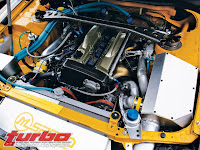
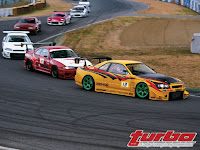
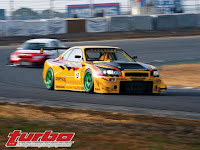

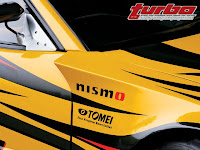

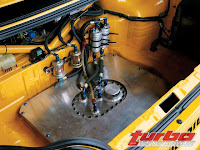







0 comments:
Post a Comment